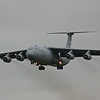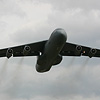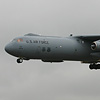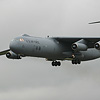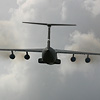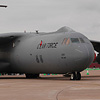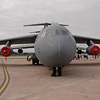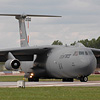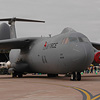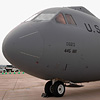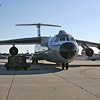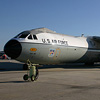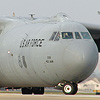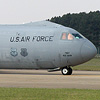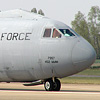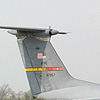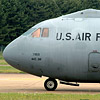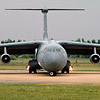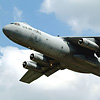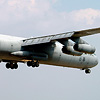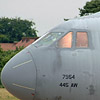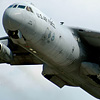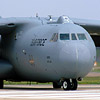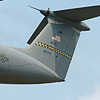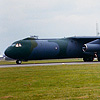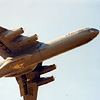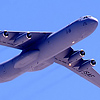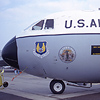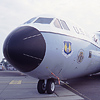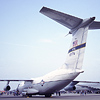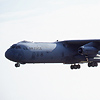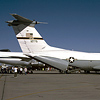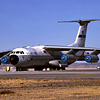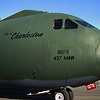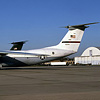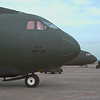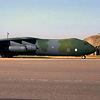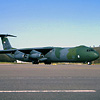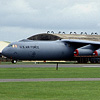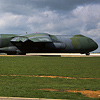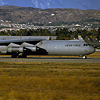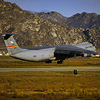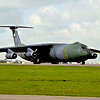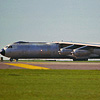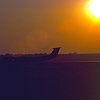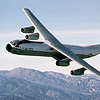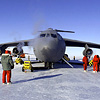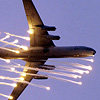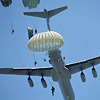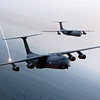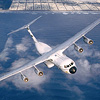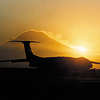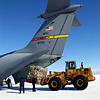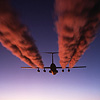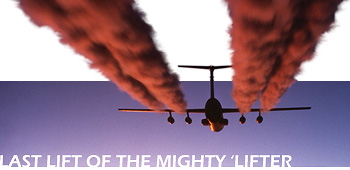
C-141 Starlifter Retirement Feature Report
2006 will be a sad year for military aircraft retirements. The Fleet Air Arm's Sea Harrier FA.2, the RAF's Canberra PR.9 and the US Navy's F-14 Tomcat will, amongst others, all be withdrawn from service during the year. Another lesser-publicised aircraft retirement for next year will be the Lockheed C-141 Starlifter. The 'Lifter', as the type is affectionately known amongst aviation enthusiasts, has been the backbone of the United States Air Force transport fleet for more than forty years.
looks at the history of the USAF's first ever dedicated jet transport and its impending retirement from operational service. Photography by , , , , , , , and official .
In early 1960, the United States Air Force declared a proposal requesting a new cargo lifter. At the time, Military Air Transport Service (MATS) was solely dependent on piston-engined transport aircraft. The proposal, known as Specific Operational Requirement 182 (SOR 182), stated the need for a long-range, jet-powered, versatile transport aircraft, with a principal role of hauling cargo and troops. SOR 182 dictated an aircraft with a cargo capacity of 60,000 pounds and a range of 4,025 miles. The aircraft would have strategic reach, coupled with a tactical airlift capability, enabling it to operate from badly-prepared strips, and be able to both undertake short-takeoff and landing (STOL). The aircraft should also be capable of dropping paratroops. In a very volatile time during the Cold War, these new unique capabilities would give the USAF the ability to react much faster to any incident around the globe.
On December 21st 1960, requests for proposals were sent to Boeing, Douglas, Convair, and Lockheed, judged to be the best suited to produce an aircraft fitting the requirements criteria. On 13 March 1961, President John F. Kennedy announced that the Lockheed Aircraft Corporation had won the competition. An initial contract for five development, test, and evaluation aircraft was submitted to Lockheed. The new aircraft was christened the "C-141A Starlifter".
It is not surprising that Lockheed incorporated many similar design traits from their venerable and highly successful C-130 Hercules, into their C-141A design proposal for SOR 182. Both types have an identical fuselage cross section (10ft x 9ft), high wing, clamshell rear doors that could be opened in-flight for airdrops, main landing gear that retracted into fairings alongside the fuselage (this made the cargo hold unobstructed) and a rear cargo ramp. Differences on the Starlifter included a large T-tail and a wing-sweep of 23 degrees, which helps the aircraft cruise at higher speeds, while also improving low-speed field performance. The aircraft is powered by four Pratt & Whitney TF33-P-7 Turbofans with each rated at 21,000 pounds of thrust, with reverse thrust to further help enhance the aircrafts STOL attributes. They are mounted in pods on underwing pylons, instead of the Hercules's turboprops mounted on the wing.
The Starlifter design boasted a few advantages over the Hercules. It was able to fly higher, faster and further than the C-130 and was also able to carry larger payloads, but doesn't have a full rough-field capability like the Hercules.
The aircraft had a standard flight crew of five, including pilot, co-pilot, navigator, engineer and a loadmaster. The first flight for the new C-141A (61-2775) was on 17 December 1963, the 60th anniversary of the Wright Brothers first flight. After a successful flight test programme, the Air Force signed a contract for the production of 127 C-141As, to complement the five development aircraft (which later became known as NC-141A's).
The first production C-141A (63-8088) was delivered to the USAF Military Airlift Command (MAC, successor to MATS) at Travis Air Force Base, California on 23 April 1965. The Air Force would go on to procure a total of 284 C-141As, with the last one running off the production line on 27th February 1968. The C-141A was originally delivered to MATS in a natural silver finish, before adopting the Military Airlift Command's (MAC) white and grey scheme.
To detail some of the different loads the C-141 can carry, they include a Sheridan tank, an AH-1 Cobra helicopter, 200 troops, 155 paratroops, or five HMMWV vehicles. Other loads can include aircraft engines, food supplies, fuel drums or weapons. The Starlifter was the first ever jet transport that US Army paratroopers used. The aircraft has a pressurised cabin and crew station. In its aeromedical evacuation (Medevac) role, the Starlifter can carry about 103 litter patients, 113 ambulatory patients or a combination of the two. In their heyday Starlifters equipped a total of thirteen Airlift Wings and twenty one Squadrons across the USAF.
A small number of Starlifters were modified to transport the Minuteman intercontinental ballistic missiles in their special containers, up to a total weight of 92,000 pounds.
One of the NC-141As, the L-300 prototype for a commercial Starlifter that never went into production, was obtained by the NASA as a flying astronomical observatory and designated the Kuiper Astronomical Observatory (KAO). KAO was primarily intended to perform infra-red observations of cosmic objects with a 91 centimetre telescope, mounted to perform observations out of a hole in the fuselage. Such observations had to be performed at high altitude, since the atmosphere absorbs infra-red radiation. KAO went into service in 1974, and obtained many significant astronomical observations. This flying observatory was retired in 1995.
In its early operational years, it is rumoured that a C-141A visited the U.S.S.R. After landing the Russians were very interested in this shiny new American transport. Not surprisingly, a few years later saw the emergence of the Russian equivalent, the IL-76 Candid. On looks alone some of the similarities are uncanny. The Candid has been referred to as the "Red Starlifter".
The C-141 has had an eventful and busy career, being used in almost every confrontation or humanitarian relief effort the United States has been involved with from its outset. No sooner had the aircraft became operational, did it have to prove its worth, with the outbreak of war in Vietnam. The first flights to Vietnam were on 5th August 1965, this saw the beginning of daily shuttle flights from the continental US to Vietnam, carrying 138 passengers in rearward-facing seats (a configuration that was deemed to provide better safety in the event of an accident) or up to ten standard 463L pallets with a total of 62,700 pounds of cargo to the war zone, and often returning to the US on Medevac flights.
Arguably the most famous Starlifter ever built is C-141A (66-0177), known as the "Hanoi Taxi". This was the aircraft that brought the first 40 American POWs from Gia Lam Airport, Hanoi, North Vietnam to start Operation Homecoming in 1973. Its name comes from the writing on the flight engineer's panel by the POWs aboard the plane on the flight. Signatures of the freed prisoners have been preserved on the panel ever since.
Retired Navy Captain Robert Doremus, a former POW who rode on 66-0177, had said that when the North Vietnamese drove them to the aircraft, every prisoner vowed to remain totally silent. "We kept straight faces until takeoff, but as soon as the wheels were in the well, we let go. That cheer will be with me forever. I'll never forget my ride on 177."
In the summer of 2002 during routine maintenance at Robins AFB, Air Force Reserve Command decided to repaint the aircraft in the 1970s white and grey paint scheme. Passengers are now greeted with the phrase; "First C-141 to Hanoi" in bold letters above the forward entrance door, with its many plaques and pictures of Operation Homecoming onboard, 177 is now a "flying museum". The aircraft is still in service at the time of writing, as a C-141C, and is part of 445th Airlift Wing based at Wright Patterson AFB, Ohio. During Operation Homecoming, Starlifters brought back some 500 US POWs from Vietnam.
MAC found that the Starlifter's cargo hold volume was small compared to its weight-lifting capability. The aircraft often ran out of space well before it met its weight limit. To resolve this problem, in 1976 the USAF began a programme to stretch the Starlifter fuselage, increasing the length of the aircraft by 23 feet 4 inches and providing space for three more standard pallets, for a total of 13.
The modification also involved the addition of a boom-refuelling receptacle; this is easily recognizable as a distinct lump behind the cockpit on top of the fuselage. This gave the aircraft a greater strategic reach capability and was therefore less dependent on landing en route to destinations to refuel.
The first "YC-141B" conversion performed its initial flight on 24 March 1977. A total of 270 "C-141B" conversions were performed, with the last being delivered back to the Air Force in June 1982. The Air Force was very pleased with the conversion programme, since it came through ahead of schedule and under budget and the stretch gave MAC an increased airlift capacity equivalent to an additional 90 C-141As. Each C-141B was expected to have 45,000 flight hours following their conversion. None of the four NC-141A's test beds were upgraded. All the C-141Bs were painted in the "European One" camouflage; this paint scheme generated the unofficial nickname of "Starlizard".
Starlifters also performed admirably in Operation Nickel Grass, the US supply mission to Israel during the October War in 1973. '141's transported the majority of cargo in the Operation. In the 1980's Lifters were critical assets in "Operation Urgent Fury", in Grenada in 1983 and also "Operation Just Cause" over Panama in 1989. In "Operation Just Cause", the aircraft dropped paratroopers in combat, one drop included 2,000 men. This was the largest airborne assault since World War II. As well as these two major Operations, C-141B's were also involved in numerous humanitarian relief operations, particularly over Africa in the 1980's.
During "Operation Desert Shield", a C-141B from the 437th Military Airlift Wing at Charleston AFB, South Carolina, was the first American aircraft into Saudi Arabia, in support of the operation.
During the following year, 141's completed more missions in support of the Gulf War than any other aircraft. They logged some 7,047 (out of 15,800) missions transporting 41,400 passengers and 139,600 short tons of cargo. Eighty percent of Air Force C-141Bs were used in Operations "Desert Shield" and "Desert Storm".
In the 1990's '141's assisted peace-keeping efforts in Bosnia and also the NATO led bombing campaign in the Balkans over Serbia and Kosovo during "Operation Allied Force" in 1999.
On 12th September 2001, a day after the tragic terrorist attacks on the World Trade Centre and Pentagon, C-141's carried blood, medical supplies and 22 surgical, trauma and critical-care specialists to McGuire AFB, New Jersey, to help in the relief and rescue effort.
In the following War on Terrorism, the aircraft would again be heavily involved. During "Operation Enduring Freedom", a Starlifter carried the first load of 20 suspected Taliban and Al-Qaeda fighters captured in Afghanistan. This was an 8,000 mile journey to the US naval base at Guantanamo Bay, Cuba.
Both the C-17 and C-141 were used to transport the detainees to Cuba. Extra security was put in place for each ferry flight; the cockpit door was protected by a four-person cockpit denial team, as a security precaution.
In the build up and during "Operation Iraqi Freedom", Starlifters once again supported the war, transporting troops, equipment, supplies and conducting Medevac flights from the theatre of operations back to Europe and the US. Starlifters would often operate out of Ramstein AB, Germany, several times a week to bring back wounded, sick or injured troops. Since 2002, C-141s have flown more than 2,000 combat sorties and moved more than 70 million pounds of war-fighting material. More impressively the aircraft have transported more than 70 percent of the sick, injured or wounded out of the Middle East.
Another exclusive achievement to the already long list for the aircraft was that it was also the first ever jet transport to land in Antarctica. This took place on November 14, 1966 and signalled the start of "Operation Deep Freeze". The flights were in support of the National Science Foundation, which operates scientific stations on Antarctica to explore the origins of the universe and mankind. Starlifters would fly to Christchurch, New Zealand and then onto the 10,000ft long Pegasus runway at the McMurdo Research Station, Antarctica. The last ever C-141 Deep Freeze flight was on 4th February 2005, the C-17 has since taken over the mission.
With the end of the Cold War and differing priorities, MAC was reorganised into Air Mobility Command (AMC) in June 1992. Shortly after, almost all of the AMC's dedicated transport fleet, including the Starlifters, adopted the current "Proud Grey" scheme, replacing the Green European Camo scheme.
In 1994, the Air Force began a programme to refit 13 C-141Bs to the Special Operations Low-Level II (SOLL II) standard. These aircraft were operated by the USAF on behalf of the US Special Operations Command and include gear for low-level night flying, as well as defensive counter-measures. The aircraft were based at Charleston AFB, South Carolina and were part of the 16th Airlift Squadron, 437th Airlift Wing. The unit's motto was "Darkness Brings Death".
The SOLL II Starlifter is similar in appearance to the C-141B, but it can be recognized by three lumps on its chin. One is directly under the nose and houses a forward looking infra-red (FLIR) imager. The other two lumps are chaff-flare dispensers, which are mounted either side of the aircraft's nose. There are also chaff-flare dispensers in the landing-gear wheel wells and on the wingtips. Other differences include an infra-red missile warning sensor fitted under the fuselage, and a radar warning receiver on the nose and tail. The SOLL II Starlifter also includes an enhanced suite of communications equipment and Global Positioning System navigation gear.
"These are the guys who are closest to the line of fire so to speak," said Lt. Col. James Farrar, 9th Airlift Squadron commander. "When SOLL II crews get tasked, they know they are going into a very serious, potentially volatile and most definitely dangerous situation".
The unit was able to rapidly deploy and inserted special operations ground forces into blacked-out, austere airfield or drop zones and extracted those forces upon completion of their mission. SOLL II Starlifters officially began standing-down on April 9th, 1999. They have since been replaced by specially equipped SOLL II C-17s.
The C-141C is an upgrade from the B models cockpit, essentially a Glass Cockpit upgrade. The modification features Multi-functional displays instead of dials, to display a multitude of information to the crew. The screens provide enhanced navigation accuracy, global position system, communications and other avionics data. From 1999 to 2001, 63 B models were converted to C models with an upgrade modification. This programme was intended to obtain incremental life out of the aircraft, rather than keep it in service over the long term. All 63 aircraft that received the upgrade were considered "low-hour".
After the types extensive use in the first Gulf War, structural problems were found, this led to flight restrictions being imposed, though these problems were quickly resolved by a repair programme. The war had dramatically increased the ageing fleet's airframe hours. To slow down aircraft ageing of the active duty fleet, 56 aircraft were transferred to the Air National Guard and Air Force Reserve Command during the mid-1990's.
In the late 1970's, the USAF began work on a new airlifter, that would ultimately become the Starlifters successor. The new aircraft would be larger, have a greater cargo-lifting payload, be able to carry larger more varied cargo and also maintain a STOL capability. The project suffered delays, although the end result is the finest and most capable airlifter in the World today - the Boeing C-17 Globemaster III.
The USAF is committed to buying 180 C-17s, with the production line likely to remain open until at least 2008. In May 2005, 135 C-17s had been delivered to the USAF. Additional orders are probable. The C-17 obtained its Initial Operational Capability (IOC) with the USAF in 1995. This milestone started to signal the end for the Starlifters glittering career. As more C-17's became operational they gradually replaced Starlifters in AMC. There were a total of 99 C-141s in service worldwide by the end of 2001. The entire AMC active duty fleet of C-141's was retired in 2003, leaving all the remaining C-141 units as part of Air Force Reserve Command.
The penultimate Starlifter operators were the 452nd Air Mobility Wing March Air Reserve Base, California. Their Starlifters were all sent to the boneyard at Davis-Monthan AFB, in the spring of 2005. The 452nd will also convert to the C-17.
Additionally to the winding down of C-141 operations, in May 2005 paratroops jumped out of the aircraft for the last ever time. In July the last three Crew Chiefs the Air Force would ever train on the type graduated.
The last remaining C-141Cs are with Reserve unit the 445th Airlift Wing at Wright-Patterson AFB, Ohio, when at full strength the wing operated 16 C-141C's. In late September 2005 the 445th AW, was operating a mere eight remaining C-141C's, but mid-November this was down to just six. All the remaining operational C-141C's will be sent to AMARC by the end of January 2006. The Hanoi Taxi will be retired to the Air Force Museum. The 445th AW will re-equip with C-5 Galaxies. The first of 11 C-5 Galaxy aircraft will arrive at Wright-Patterson AFB on October 3rd 2005.
A further chapter will close on the C-141 on 30th September. 445th AW 'Lifters will make the type's final sorties outside the continental United States on behalf of Operation Iraqi Freedom. Whilst on course back to the US, the aircraft are scheduled to attend a farewell ceremony at Ramstein AB, Germany for the Starlifter's passing from service.
In the past Starlifters have always been fairly regular attendees at UK airshows. Over the last decade with the drawdown of operations and diminishing numbers, plus the United States heavy commitments and operations all over the World, airshow appearances have become few and far between.
Some of the more memorable appearances over the past few years have included an extremely rare appearance by NC-141A "Desert Rat" (61-2776) 412th TW on Static display at Air Fete 1998 at RAF Mildenhall. This particularly aircraft was sent to the boneyard in August that year. Three years later, at the last Air Fete, a C-141 dropped the US Army's Parachute team the Golden Knights and also performed a flyby. The last ever appearance of a C-141 at a UK airshow was at the Royal International Air Tattoo 2004, a single static 'Lifter from the 445th AW was present.
The organisers of the Royal International Air Tattoo 2005 almost pulled off a major coup when they had managed to provisionally book the Hanoi Taxi to attend the show in the static. Unfortunately the 445th AW had to cancel the aircrafts appearance about a month before the show, due to operational commitments. A real shame, as this particular legendary aircraft and type will never be seen again by UK airshow enthusiasts.
Despite rapidly heading towards its retirement, the remaining 'Lifters have been busy at work all around the World. C-141's brought supplies for the relief effort by the devastating Tsunami in late 2004.
The aircraft was again pivotal, much closer to home, in the relief effort in the aftermath of Hurricane Katrina in Louisiana. 445th aircraft evacuated patients to hospitals in other States and also brought in urgent supplies to the New Orleans area. Only a few weeks later and 'Lifters were again aiding the relief effort after Hurricane Rita.
In the latter days of its career the C-141 has clearly excelled in its Medevac role, being the types primary role in its last few years of service.
The vast majority of C-141's now are languishing in the heat of the Arizona desert, at the Aerospace Maintenance and Regeneration Centre (AMARC), at Davis-Monthan AFB. Many of which have already fallen foul to the scrapmans torch. A small number have been preserved and are on display in museums around the United States.
It has recently been confirmed that the last ever C-141 flight will be by the Hanoi Taxi in the first week of May 2006, just prior to it being handed over to the Air Force museum. There is expected to be a ceremony with many of the POW's who flew on it in attendance at Wright-Patterson. This will be the very final chapter in the aircrafts successful career.
As with all aircraft, nothing lasts forever. Now this charismatic aircraft, with its distinctly smokey and whiney engines, is very much in the twilight of its career. In its service to the USAF over the forty years, the C-141s have worked tirelessly alongside the C-130s, C-5s and C-17s. It achievements have probably surpassed the Lockheed designers and the USAF's wildest dreams and expectations when she first rolled off the production line. I for one, hope the aircraft is given the send off it thoroughly deserves in January 2006. If you're lucky enough to get the opportunity to see this now extremely rare but classic aircraft operationally before it's retired, make the most of it. You may never get this chance again!

